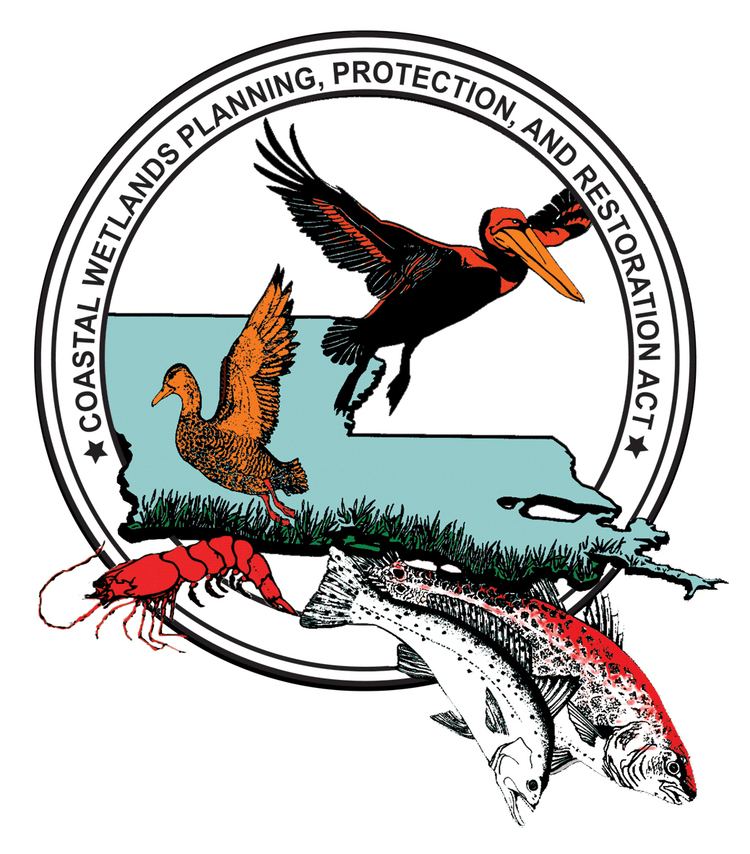Formed 1990 Website LaCoast.gov | Annual budget $78.6M FY15 | |
 | ||
Parent agency USACE, NOAA, FWS, NRCS, EPA, State of Louisiana | ||
The Coastal Wetlands Planning, Protection and Restoration Act (CWPPRA) was passed by Congress in 1990 to fund wetland enhancement. In cooperation with multiple government agencies, CWPPRA is moving forward to restore the lost wetlands of the Gulf Coast as well as protecting the wetlands from future deterioration. The scope of the mission is not simply for the restoration of Louisiana’s Wetlands, but also the research and implementation of preventative measures for wetlands preservation.
Contents
- Introduction
- CWPPRA
- Funding
- Basin Project Areas
- Project Types
- Benefits of CWPPRA Projects
- CWPPRA Task Force Members
- The Hurricane Effect
- Related Restoration Projects
- References
CWPPRA is a partnership between the U.S. Army Corps of Engineers, the NOAA- National Marine Fisheries Service, the U.S. Fish and Wildlife Service, USDA Natural Resources Conservation Services, the Environmental Protection Agency, and the State of Louisiana.
Introduction
Like most deltaic systems, the Louisiana coast is sinking. The natural occurrence of subsidence was historically offset by new sediment from the annual overflow of the Mississippi River. With construction of the river levees, this overflow was cut off, leaving the wetlands to continue sinking with no source of renourishment. Since the early 1900s, storms and anthropogenic impacts have compounded with subsidence to cause drastic land loss in coastal Louisiana. In the past century, Louisiana has lost more than 1 million acres from its coast, 24 square miles annually, because of both human and natural factors that have disrupted ecological and economic stability. Billions of dollars in seafood production, oil and gas revenue, and commercial shipping will be lost without Louisiana’s coastal wetlands, which provide the basis and support for these industries. In terms of human life, the value of these wetlands is beyond estimation. Healthy marsh provides a buffer against storms, and its ability to absorb high water and slow wind is key to survival for coastal communities. As land is lost, hurricanes and tropical storms hit shore ever closer to the two million people who live near the coast. Every year as wetlands lose ground, these forces land closer to home. Without intervention, this ecosystem will be erased from the national landscape.
CWPPRA
The Coastal Wetlands Planning, Protection and Restoration Act (CWPPRA) is also known as the Breaux Act due to the involvement of Louisiana U.S. Senator John Breaux in the Act’s passage.
The Act has several mandates:
Since 1990, 210 CWPPRA Projects have been authorized.
Funding
The Sport Fish Restoration and Boating Trust Fund is CWPPRA's funding source supported by excise taxes on fishing equipment and small engine and motorboat fuel taxes. Funding for Louisiana CWPPRA projects is cost shared: a split of 85 percent Federal and 15 percent State of Louisiana. Funding for the Sport Fish Restoration and Boating Trust Fund is authorized through 2021 by the Fixing America's Surface Transportation (FAST) Act of 2015. The Trust Fund contributes 18.5 percent of its annual revenues to CWPPRA appropriations; that amount is divided as follows:
While the funds for the CWPPRA program are authorized through 2021, the program itself has only been re-authorized through FY 2019 by the Consolidated Appropriations Act of 2004.
Basin Project Areas
Project Types
Many restoration projects employ two or more restoration techniques.
Benefits of CWPPRA Projects
Benefits that CWPPRA projects contribute:
CWPPRA Task Force Members
The task force consists of the State of Louisiana and five Federal Agencies:
Contact information for CWPPRA Task Force members can be found at LACoast.gov.
The Hurricane Effect
In 2005, two of the United States' most devastating hurricanes hit the Gulf Coast (Hurricane Katrina, August 2005; Hurricane Rita, September 2005). Their impact gained national attention due to the vast property damage and loss of life. These two storms also impacted CWPPRA efforts for coastal restoration, for the better. As scientists and policy makers seek ways to protect coastal communities and industries from future hurricanes, they look to the marshes and barrier islands that form the coast’s first line of hurricane defense. This is magnifying the importance of CWPPRA and related projects and the necessity for the successful restoration of the coastal wetlands.
More recently, in 2008, Hurricanes Gustav and Ike have left their mark on Louisiana's Coastal Wetlands. Experts are comparing Hurricane Ike's impacts to those of Hurricane Rita in 2005. Assessment of the impact is on-going and may not be fully realized for some time.
